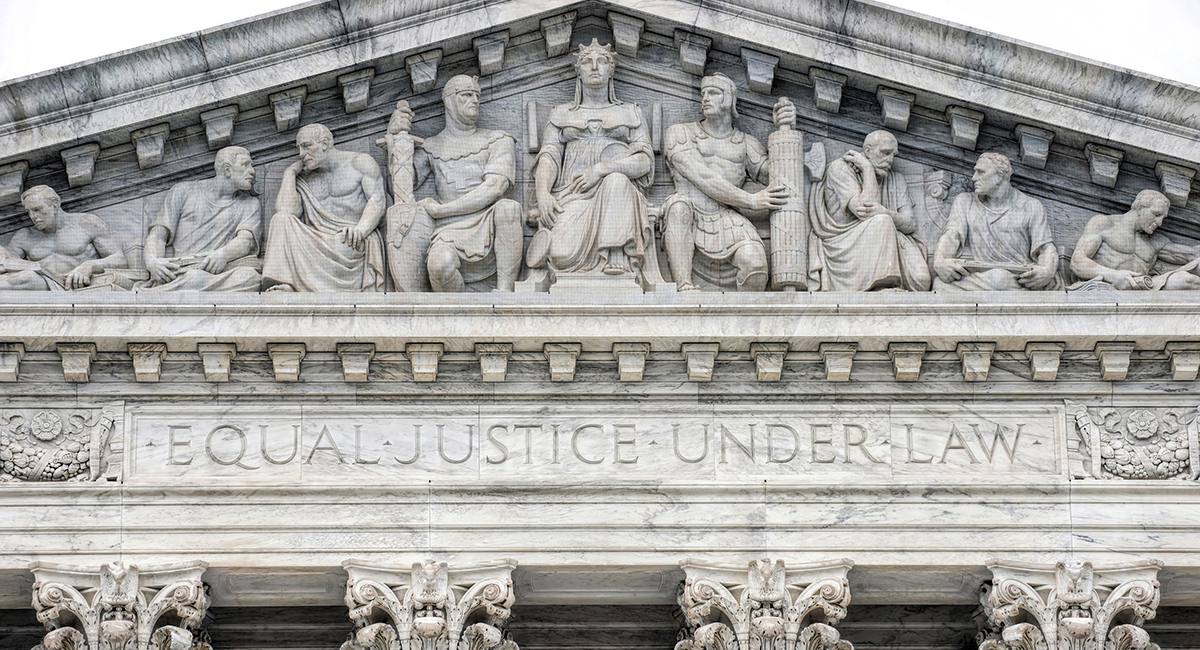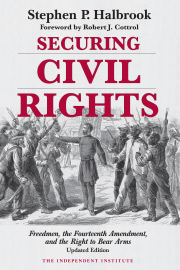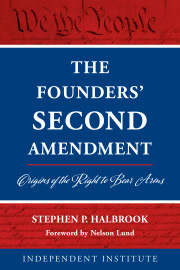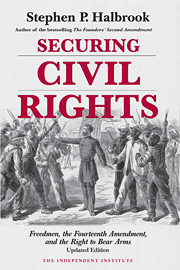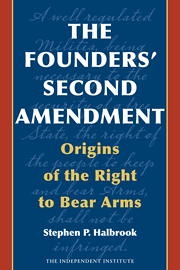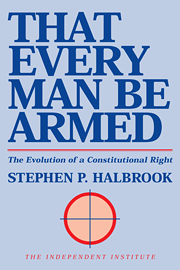In a previous post, I wrote about the attempt by Merrick Garland’s Justice Department in United States v. Rahimi, set to be argued before the Supreme Court on November 7, to sidestep the controlling “text and history” interpretative methodology described in District of Columbia v. Heller and in New York State Rifle & Pistol Ass’n v. Bruen. Rahimi is the case challenging the facial constitutionality of 18 U.S.C § 922(g)(8), a federal statute that disarms any individual subject to a state domestic violence restraining order (DVRO). In that post, I explained how the Government is contending, contrary to Bruen, that the established rule is that “Congress may disarm persons who are not ‘law-abiding, responsible citizens.’” That statement is not just incorrect, but a serious distortion of what Heller actually said.
As it turns out, the Government’s recently filed reply brief contains several other important errors about the fundamental principles to be applied when assessing historical analogue laws, which are central to Bruen’s methodology. Let’s start with an easy one. The Government takes Rahimi to task for allegedly asserting that Bruen limits courts to historical evidence from “near the time of ratification.” Here’s what Rahimi’s brief actually said, after discussing attempts by some courts to boost some dicta in Heller to the level of substantive constitutional law:
[T]he original meaning of the Second Amendment must be determined exclusively using the text and the historical tradition of firearm regulations adopted near the time of ratification—not with assumptions or dicta.
That statement by Rahimi was contrasting the use of actual historical traditions to determine the meaning of the Second Amendment, as opposed to twenty-first century dicta, or assumptions by lower courts regarding what those dicta meant. It was not an attempt to fine tune the period of time with precision.
Yet Rahimi is correct that the time around the adoption of the Bill of Rights must be the principal period to determine the original public meaning of its provisions. Bruen quoted Heller to the effect that “Constitutional rights are enshrined with the scope they were understood to have when the people adopted them,” before noting that “The Second Amendment was adopted in 1791....”
The Bruen opinion also quoted approvingly a dissent by then-Judge Kavanaugh: “post-ratification adoption or acceptance of laws that are inconsistent with the original meaning of the constitutional text obviously cannot overcome or alter that text.” The six-person Bruen majority also relied on a dissenting statement by Chief Justice Roberts, in Sprint Communications v. APCC Services (2008), that “The belated innovations of the mid- to late-19th-century courts come too late to provide insight into the meaning of [the Constitution in 1787].” The same is true of the Bill of Rights, adopted in 1791.
The Government claims in its brief that “the Court has consulted post-ratification evidence—extending ‘through the end of the 19th century’—‘to determine the public understanding of’ the Amendment.” But as Bruen notes, another case made clear that this evidence was reviewed “only after surveying what [the Court] regarded as a wealth of authority for its reading—including the text of the Second Amendment and state constitutions.” Bruen continues, “In other words, this 19th-century evidence was ‘treated as mere confirmation of what the Court thought had already been established.’” See also Justice Barrett’s concurrence in Bruen, quoting Espinoza v. Montana Dept. of Revenue (2020) (a practice that “arose in the second half of the 19th century ... cannot by itself establish an early American tradition” informing our understanding of the First Amendment); Mark W. Smith, Attention Originalists: The Second Amendment Was Adopted in 1791, not 1868, Harvard Journal of Law & Public Policy Per Curiam (Fall 2022).
So Rahimi is right. A court must look principally to the Founding era to determine the meaning of the Second Amendment. It can look at later evidence only for confirmation, not to change the original understanding.
The Government also has some peculiar notions about the use of analogues for determining historical meaning. The Government accuses Rahimi of arguing that the meaning of the Second Amendment must be discerned “exclusively using * * * firearm regulations.” It then argues, citing Heller, that other sources may be used, such as “English history,” “analogous provisions in state constitutions,” “Second Amendment precursors,” “commentary,” “case law,” and “legislative debates.” The Government then complains that “Rahimi gives no reason to ignore those historical sources here....”
Of course he doesn’t, because he is not arguing that such sources should be ignored. But here is the key: the tradition of firearms regulation (or lack of regulation) must be established only by constitutions, statutes, ordinances, judicial decisions, or other enactments or decisions that had (or were thought to have) the force of law. It’s true that secondary sources may sometimes be relevant to the meaning of the Second Amendment — but only to the extent they discuss firearms regulations (or a lack thereof) that were binding with legal force.
Commentaries, correspondence, newspaper articles, and other secondary sources have relevance only to the extent they describe an enactment or decision that has the force of law (or the absence of one).
For example, Bruen explains that “why” a regulation was imposed is a key part of the historical analysis. A commentary or other non-regulatory source may provide insight into why a particular regulation was adopted. If there is ambiguity in the text of a regulation, a commentary may also provide insight into “how” a regulation restricted the right to keep and bear arms, another key part of the Bruen analysis. Of course, as Bruen also makes clear when discussing Sir John Knight’s case and the surety laws, to the extent there is any uncertainty about the scope of a restriction, the restriction will be interpreted in a way more protective of Second Amendment rights.
Neither does Rahimi’s application of Bruen create a “regulatory straitjacket” as the Government claims. Congress, to the extent it has jurisdiction under Article I, § 8 of the Constitution, is free to enact a system of preventative justice, provided, of course, there is a distinctly similar analogue at the time of the founding.
So, for example, if the government wanted to adopt a surety system it likely could, assuming Congress had Article I authority. But surety laws cannot support 922(g)(8) as the method of achieving the statutory goal (i.e., the “how”) because § 922(g)(8)’s disarmament effect is entirely different than a surety system: in the surety system, no one was disarmed provided the principal undertook a recognizance and sureties (if necessary) were obtained. Section 922(g)(8), by comparison, imposes a total ban on the possession of firearms for any and all lawful purposes including for armed self-defense.
A note about a footnote: Section 922(g)(8) has two subparagraphs, either of which can trigger the arms ban. Subparagraph 922(g)(8)(C)(i) imposes the arms ban if the underlying DVRO contains a finding that the individual poses a “credible threat to the physical safety of such intimate partner or child.” Alternatively, subparagraph 922(g)(8)(C)(ii) imposes the ban simply because the individual is restrained by the DVRO from the “use, attempted use, or threatened use of physical force against such intimate partner or child that would reasonably be expected to cause bodily injury.” It does not require that the individual actually used, attempted to use, or threatened to use physical force, or is likely to do any of those things, but only that he or she is restrained from doing so.
In a footnote on page 15 of its reply brief, the Government notes that an amicus brief filed by certain Professors of Second Amendment Law accepts “the validity of Section 922(g)(8)(C)(i) because it ‘requires a judicial finding of dangerousness’ but reject[s] Section 922(g)(8)(C)(ii) because it does not require a specific finding.” The Government disagrees with the professors, arguing that “History and tradition establish legislatures’ authority to disarm dangerous or irresponsible categories of persons, and the category of individuals subject to protective orders specifically prohibiting the use of force against partners or children surely qualifies.”
That is mistaken. The “category of individuals subject to protective orders specifically prohibiting the use of force against partners or children” does not qualify, because such orders can and frequently do issue against people who are not dangerous. As Judge Ho noted in his concurrence in the Rahimi Fifth Circuit opinion, such orders are commonly issued without any showing of dangerousness in divorce cases, and are sometimes issued against both parties to the divorce. So (C)(ii) is clearly unconstitutional. The Government attempts to backstop this losing argument by asserting that “any defect in subparagraph (C)(ii) would not assist Rahimi because his order included the finding required in subparagraph (C)(i).” That is equally mistaken. Rahimi brought a facial challenge to the statute, so it doesn’t matter what was contained in his particular order.

